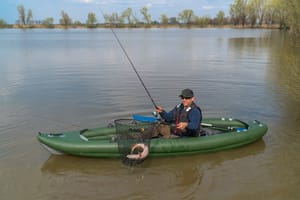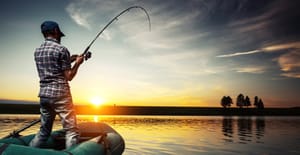Fishing from a kayak has surged in popularity as anglers seek the serenity and access that these small, nimble vessels provide. However, for those new to kayak fishing, one question often looms large: Are fishing kayaks easy to tip over? This article will delve into the factors that affect kayak stability, offer tips to prevent capsizing, and provide insights into choosing the right kayak for your fishing adventures.
Key Takeaways:
- Fishing kayaks are designed with stability in mind, but certain factors can affect their likelihood of tipping.
- Understanding the different types of kayak stability and the role of the paddler can help prevent capsizing.
- Choosing the right kayak and using proper techniques are crucial for a stable and enjoyable fishing experience.
The Design of Fishing Kayaks for Stability
Fishing kayaks are specifically crafted to offer greater stability than their recreational or touring counterparts. This is achieved through wider hulls, which provide a larger surface area in contact with the water. The width of a fishing kayak is a critical factor in its primary stability, or how stable it feels when you first step into it and sit still.
Manufacturers often employ various hull designs to enhance stability. For example, pontoon hulls, which feature two separate running surfaces, can offer an excellent balance between primary and secondary stability. Secondary stability refers to how well a kayak resists tipping over when it's leaned on its side. The shape and width of the hull play a significant role in this aspect of stability.
The Role of the Paddler in Kayak Stability
While the design of the fishing kayak is paramount in determining its stability, the paddler's actions and skill level are equally important. Experienced kayakers know how to distribute their weight evenly and use their body to maintain balance. They understand the importance of keeping their center of gravity low and making smooth, deliberate movements.
Paddlers should also be aware of how to properly enter and exit the kayak to avoid tipping. It's recommended to practice these maneuvers in calm, shallow water before heading out to fish. Additionally, learning how to perform a low brace—a technique used to stabilize the kayak with the paddle when it starts to tip—can be a lifesaver in preventing capsizing.
Factors That Affect Kayak Stability
Several factors can influence the stability of a fishing kayak, including the paddler's weight and height, the distribution of gear, and environmental conditions. A kayak that is heavily loaded or improperly balanced can become unstable. It's crucial to evenly distribute weight and secure gear to prevent it from shifting while on the water.
Environmental conditions such as wind, currents, and waves can also challenge a kayak's stability. It's essential to choose a kayak that suits the conditions you'll most frequently encounter. For instance, a kayak with good secondary stability might be preferable in choppy waters, whereas a kayak with excellent primary stability might be better for calm lakes.
Choosing the Right Fishing Kayak for Stability
When selecting a fishing kayak, consider the types of water you'll be fishing in and your personal comfort level with kayak stability. Sit-on-top kayaks are often recommended for fishing due to their higher degree of primary stability and ease of re-entry if you do tip over. They also typically have scupper holes that allow water to drain out, which can be beneficial in rougher conditions.
The length of the kayak can also impact stability. Longer kayaks tend to track better and can be faster, but they might not be as maneuverable as shorter ones. Test different models to find the right balance of stability, speed, and maneuverability for your fishing needs.
Techniques to Improve Stability While Kayak Fishing
Proper paddling technique can greatly enhance your kayak's stability. Paddling with smooth, even strokes and maintaining a rhythm can help keep the kayak balanced. Additionally, when fighting a fish, it's important to stay centered and avoid sudden movements that could shift your weight too far to one side.
Another technique to improve stability is to use an anchor or a drift chute when fishing. These tools can help keep your kayak stationary, reducing the movement caused by wind or current that could lead to tipping. Always be mindful of the conditions and be prepared to adjust your position or stabilize yourself with your paddle if necessary.
Summary
Fishing kayaks are designed with stability in mind, but whether they are easy to tip over depends on a variety of factors. The kayak's design, the paddler's skill and actions, the distribution of gear, and environmental conditions all play a role in stability. By understanding these factors and choosing the right kayak, paddlers can enjoy a stable and secure fishing experience. Remember to practice proper techniques and always be prepared for changing conditions on the water. Gain confidence on the water by understanding the stability of fishing kayaks, and don't forget to explore our Best Fishing Kayak 2024 | Our Top 9 Picks for top-notch options!
FAQ Section
What type of fishing kayak is the most stable?
Sit-on-top fishing kayaks are generally considered the most stable due to their wide hulls and higher primary stability. They are also easier to re-enter if you do tip over.
Can I improve the stability of my fishing kayak?
Yes, you can improve stability by practicing proper paddling techniques, evenly distributing weight, securing gear, and using stability aids like anchors or drift chutes.
Is it common for fishing kayaks to tip over?
While fishing kayaks are designed for stability, tipping over can still happen, especially if the kayak is improperly loaded, the paddler makes sudden movements, or if environmental conditions are challenging. However, with the right kayak and techniques, tipping over is not a common occurrence.



